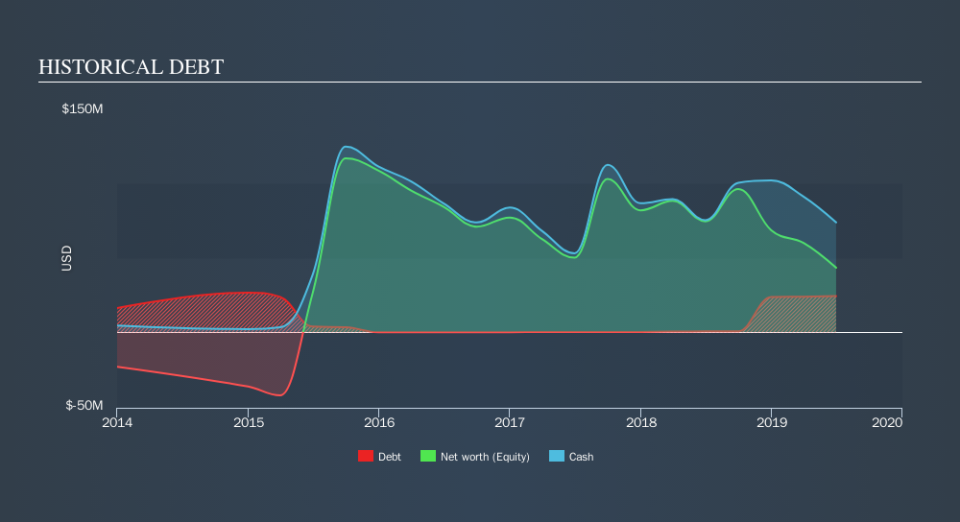Is Nabriva Therapeutics (NASDAQ:NBRV) Using Too Much Debt?

Legendary fund manager Li Lu (who Charlie Munger backed) once said, 'The biggest investment risk is not the volatility of prices, but whether you will suffer a permanent loss of capital.' It's only natural to consider a company's balance sheet when you examine how risky it is, since debt is often involved when a business collapses. We can see that Nabriva Therapeutics plc (NASDAQ:NBRV) does use debt in its business. But the real question is whether this debt is making the company risky.
When Is Debt Dangerous?
Debt assists a business until the business has trouble paying it off, either with new capital or with free cash flow. Part and parcel of capitalism is the process of 'creative destruction' where failed businesses are mercilessly liquidated by their bankers. While that is not too common, we often do see indebted companies permanently diluting shareholders because lenders force them to raise capital at a distressed price. Of course, debt can be an important tool in businesses, particularly capital heavy businesses. The first step when considering a company's debt levels is to consider its cash and debt together.
See our latest analysis for Nabriva Therapeutics
What Is Nabriva Therapeutics's Debt?
You can click the graphic below for the historical numbers, but it shows that as of June 2019 Nabriva Therapeutics had US$24.3m of debt, an increase on US$592.0k, over one year. But it also has US$73.9m in cash to offset that, meaning it has US$49.6m net cash.
How Strong Is Nabriva Therapeutics's Balance Sheet?
We can see from the most recent balance sheet that Nabriva Therapeutics had liabilities of US$14.1m falling due within a year, and liabilities of US$26.1m due beyond that. On the other hand, it had cash of US$73.9m and US$4.77m worth of receivables due within a year. So it actually has US$38.4m more liquid assets than total liabilities.
This surplus suggests that Nabriva Therapeutics is using debt in a way that is appears to be both safe and conservative. Because it has plenty of assets, it is unlikely to have trouble with its lenders. Succinctly put, Nabriva Therapeutics boasts net cash, so it's fair to say it does not have a heavy debt load! There's no doubt that we learn most about debt from the balance sheet. But ultimately the future profitability of the business will decide if Nabriva Therapeutics can strengthen its balance sheet over time. So if you want to see what the professionals think, you might find this free report on analyst profit forecasts to be interesting.
Over 12 months, Nabriva Therapeutics saw its revenue drop to US$3.5m, which is a fall of 68%. To be frank that doesn't bode well.
So How Risky Is Nabriva Therapeutics?
We have no doubt that loss making companies are, in general, riskier than profitable ones. And the fact is that over the last twelve months Nabriva Therapeutics lost money at the earnings before interest and tax (EBIT) line. And over the same period it saw negative free cash outflow of US$81m and booked a US$126m accounting loss. Given it only has net cash of US$74m, the company may need to raise more capital if it doesn't reach break-even soon. Overall, its balance sheet doesn't seem overly risky, at the moment, but we're always cautious until we see the positive free cash flow. For riskier companies like Nabriva Therapeutics I always like to keep an eye on whether insiders are buying or selling. So click here if you want to find out for yourself.
If you're interested in investing in businesses that can grow profits without the burden of debt, then check out this free list of growing businesses that have net cash on the balance sheet.
We aim to bring you long-term focused research analysis driven by fundamental data. Note that our analysis may not factor in the latest price-sensitive company announcements or qualitative material.
If you spot an error that warrants correction, please contact the editor at editorial-team@simplywallst.com. This article by Simply Wall St is general in nature. It does not constitute a recommendation to buy or sell any stock, and does not take account of your objectives, or your financial situation. Simply Wall St has no position in the stocks mentioned. Thank you for reading.

 Yahoo Finance
Yahoo Finance 
